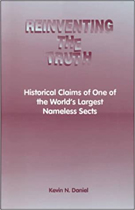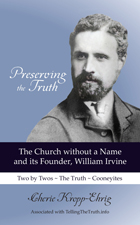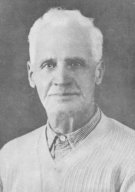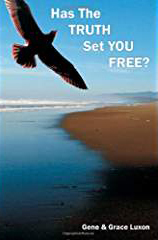What is the Significance of Wm. Irvine Being a Mason?
William Irvine was a member of the Masonic Lodge. In 1937, he wrote a letter to Berglinds stating: “I am a Mason for over 50 years.” This calculates to Irvine being initiated as a Mason in 1884 when he was 21 years old. This means that he was a Mason while he was associated with the Faith Mission. It also means that all the time he was a worker in the Go-Preacher movement (aka 2x2 Sect), he was also a Mason. It seems reasonable to assume that he had not renounced his freemasonry membership, or he would not have stated “I AM a Mason” in 1937, just ten years before his death. He wrote:
"Masonry was introduced by the Jews as a Trade protection society at the building of Solomon's Temple, and prospered in Jerusalem, and spread over the Earth in the scattering of the Jews. I am a Mason for over 50 years, though don't take any stock in it anymore than anything else which marks the old earth conditions." (September 10, 1937 Letter to Berglinds)
"You may tell your brother that I also am a Free and accepted master mason. My Mother Lodge being 547 - Stewart Scotch for past 45 years. So I know all that it means. But if I were the Grand Master or the Pres. of U.S.A. it could not avail me any thing..." (January 30, 1929 Letter to Fay Sheeley)
"I am a Free Mason and know all there is in it." (January 31, 1929 Letter to Mrs. Dilla Sheeley)
"I was asked to be present at a Masons mark degree meeting on Wednesday this week, but I have not been in a Lodge for 40 years, though I used to enjoy it when I was seeking joy and satisfaction on the human plane. A hand shake and pat on the back from a few friends is very sweet..." [1934 less 40 yrs = 1894 when Irvine was attending the Bible Institute] (August 20, 1934* Letter to Page Family, New Zealand)James L. Noble for the Grand Secretary of the Grand Lodge of Ancient Free and Accepted Masons of Scotland of Edinburgh, made a statement dated November 19, 2010: "I...can confirm that the records held within my office do show that Brother William Irvine was Initiated within Lodge Steuart [sic: Stewart] No. 547, Kilsyth, Stirlingshire on 23 January 1884; Passed to the Fellowcraft Degree on 07 January 1885; and Raised to the Master Mason Degree on 17 January 1885. His occupation is shown as a Miner, aged 25 years. Unfortunately the Lodge was declared dormant in 1898." (Copy of letter in TTT Photo Gallery)
Aguably, Noble's records for a William Irvine who was twenty-five years old in 1884-85 may not be the William Irvine born in 1863 who would be about twenty-one in 1884, who stated in 1929 that he was a mason for forty-five years. It's possible there was an error in transcription in the date in Irvine or Noble's letters, or perhaps Noble's record was for another mason by the same name. Since most families used the traditional Scottish naming pattern, there were numerous sons named William Irvine, and several to whom our William was related.Upon the death of Wm Irvine's father John Irvine, the local newspaper wrote an article about him that stated: "A Freemason, he was connected with Lodge Kilsyth St. John, filling the office of Worshipful master in his earlier days." (Kilsyth Chronicle, Aug. 15, 1913, Crimean Veteran Dies at Kilsyth. https://www.tellingthetruth.info/newspapers/scotland.php#crimean
A Mason is a member of the Order of Free and Accepted Masons. The principles, institutions, and practices of the fraternal order of the Free and Accepted Masons are referred to as Freemasonry. Reportedly, it is or was the largest worldwide fraternal society; however, its numbers are dwindling rapidly. The average age of most Lodges is increasing and they are finding it increasingly difficult to attract younger members. This international fraternity is open to men 21 years of age or older, without regard to race, color or religion, with good character and reputation, who believe in a Supreme Being and in the immortality of the soul. While some believe as Wm. Irvine did, that Masonry was introduced by the Jews during the building of Solomon’s Temple, most scholars trace modern Masonry back to 1717, when four lodges in London merged to form the first Grand Lodge.
The basic unit of Freemasonry is the local Blue Lodge, usually housed in a Masonic temple. The Blue Lodge confers three degrees. Additional degrees are conferred by two groups of advanced Freemasonry: the York Rite, which awards 12 higher degrees; and the Scottish Rite, which awards 30 higher degrees. There are related organizations for women, such as the Orders of the Eastern Star and Amaranth, as well as orders for young men and young women. Masonic lodges, halls or temples are found in most towns of any size, and are often made available for community activities.
Once accepted, a man must pass through the three Degrees of the Blue Lodge, each with its own secret ritual, handshake and password. After receiving the first three Degrees, he becomes a “Master Mason,” which is a full-fledged Mason. Masons take an oath to never reveal the secret teachings of Freemasonry. It has been called a system of morality, veiled in allegory and illustrated by symbols. Symbolism and allegory are the keys to understanding Freemasonry. The beliefs of the Freemasons are found in standard official textbooks called "Monitors," containing authoritative Masonic ritual, which are uniform for each state, more or less. Descriptions of many of the rituals for the various Degrees are found on the internet. In the rituals to obtain the 30th, 31st and 32nd Degrees, there are several references to Lucifer (Satan’s name). (http://www.biblebelievers.org.au/mason1.htm#07 )
The best known of the Masonic groups is the Shriners, who hold festive parades and support the Scottish Rite Children’s Hospitals for crippled and burned children. (To be a Shriner, one must be a 32nd degree Scottish Rite Mason, or its equivalent in the York Rite). Shriners wear the funny little red hats with a tassel (called a “fez”) and drive go-carts and motorcycles in parades and are responsible for the Shriners’ circus. Many members wear recognizable Masonic rings or pins. Masons raise large sums for charities. From its earliest days, Freemasonry has been concerned with the care of orphans, the sick and the aged. Children are treated at no charge at their hospitals.
Some view Freemasonry as an approach to God. However, Freemasonry claims they are not a political or religious organization; and that Masonry is not a substitute for church or religion. They claim it is not a religion, yet it is religious in nature, and it is referred to among Masons as the religious faith of Freemasonry. seeks to better society and help men become better members of their own faith. quires that its members believe in the existence of a Supreme Being and also to believe that there is only One God, referred to as the Great Architect of the Universe (G.A.O.T.U.) It teaches that all men, of all the various religions, worship the (same) one God, simply using a variety of different names. Christians, Jewish, Muslim, Buddhist, etc.
For
most Masons, the lodge is a fraternal club with a secret ritual
initiation that
meets once or twice a month for fellowship and to sponsor charities. Many Masons do not understand the
allegorical, mystic significance in the ritual work they are required
to
perform to obtain Degrees.
Contrary to statements by Masonic leaders, Christians and ex-Masons maintain that Freemasonry is definitely a religion. Over the years, there has been much opposition to Freemasonry by Christians, and some Christians believe Freemasonry and Christianity are totally incompatible. The Roman Catholic Church teaches that any Catholic who joins Freemasonry is in a state of grave sin and should abstain from taking Communion until they repent. There is an automatic excommunication for a Catholic who knowingly accepts beliefs incompatible with Christianity, and Freemasonry fits this category. After much controversy, the Southern Baptist, a Protestant body, ruled that Freemasonry membership is a matter of personal conscience. (C.R.I.)
Christians object to Freemasonry for many reasons. Freemasonry teaches that Jesus is not unique. It views Jesus as just a man who was not divine and certainly not the only means of redemption for lost mankind. It views Jesus as no different than any other great spiritual leader or guru. He is the son of Joseph, but not the Son of God. (Jim Shaw, The Deadly Deception (Lafayette, La.: Huntington House, Inc., 1988, pp 126-27). Freemasonry does not follow the teachings of Christ, and does not believe men are born in a sinful state. They teach salvation is by works, personal merit or character development, and not faith in Christ alone. The Lodge does not permit the name of Jesus or Christ to be used in any of its prayers or rituals.
Christians
believe there is only one God, the God of Abraham, Isaac, Jacob, and
Father of
Jesus Christ. Christians object to the foundational
belief of Freemasonry that all religions can lead a man to God and that
the God
of the Bible is equally present in all religions. In
other words, men of all the various religions, worship one
and the same God, using a variety of different names.
Masons make oaths that they believe this. Some
Christians believe Freemasonry is a
pagan religion that worships many gods, rather than the God of the
Bible. Paul warned that it was not
possible for a
man to participate in paganism and also be a Christian.
Masons make many oaths, swearing on the “Bible” of their choice; i.e. the Koran, Holy Bible, Pentateuch, Vedas, etc. Some Christians object to Masons making oaths on the basis of Matt. 5:34 and James 5:12. The Mason takes an oath that he will uphold Freemasonry and its teachings which includes, among other things, that salvation can be gained by man's good works; that Jesus is just a highly revered prophet; and that the God of the Bible is equally present in all religions.
Another Christian objection pertains to the Hiramic Legend, which is at the very heart of the foundation of all of Masonry. Hiram Abiff is portrayed as a Christ-like figure who is at the center of the Mason's view of the salvation process. In the portrayal, Hiram exhibits many of the characteristics and actions of Jesus in the Bible accounts. The final Degree for most Masons is the Third or Master Mason Degree. It is the new member’s baptism into Freemasonry. Every man who is initiated as a Master Mason, must impersonate Hiram Abiff during an acted out drama. According to Masonic legend, Hiram Abiff was the Grand Architect at the building of King Solomon’s Temple in the Old Testament.
The
name Hiram Abiff is not found in Scripture. Yet, the Masonic account of
Hiram
is often held to be based upon the Holy Bible.
Hiram was killed for refusing on three separate occasions to
divulge a
builder’s secret before the “right” time to make the secret known.
Usually without
knowing what he is doing or what it symbolizes, the Master Mason
candidate is
helped to impersonate Hiram Abiff in this drama. He
experiences the symbolism of baptism, death, burial and
resurrection, with “King Solomon” raising Hiram from the dead. This concludes the second part of the 3rd
degree. The candidate has then been
initiated into the Masonic fraternity and baptized into "the
religious
faith of Freemasonry." He is
then a full-fledged Mason. Following
the Master Mason Lecture, these words are spoken:
"Then, finally my brethren, let us imitate our Grand Master, Hiram Abiff, in his virtuous conduct, his unfeigned piety to God, and his inflexible fidelity to his trust; that, like him, we may welcome the grim tyrant, Death, and receive him as a kind messenger sent by our Supreme Grand Master, to translate us from this imperfect to that all-perfect, glorious, and celestial Lodge above, where the Supreme Architect of the Universe presides.”
Some Christians have carefully examined, the words, and believe they are actually saying that, Masonic brethren should imitate Hiram Abiff to get into heaven. It does not urge Freemasons to have faith in Hiram Abiff--it substitutes imitation (works) for faith and Hiram for Jesus, as the means to gaining entry into heaven after death. Thus, some Christians believe that Freemasonry counsels its new members to imitate Hiram to get into heaven. Hiram and other saviors only “save” themselves. By imitating Hiram and following his example, Freemasonry teaches that Masons may save themselves.
Christians object to this drama because they perceive it as a plan of salvation, or “another gospel.” The name of Jesus cannot be mentioned within the lodge, and yet a human being is substituted who takes the focus and authority of Jesus. Freemasonry teaches salvation without Jesus. Freemasonry teaches that Hiram Abiff is a savior for Freemasons, and that each man is his own savior. It does not embrace the Christian teaching of substitutionary atonement.
Regarding the issue of beliefs, the book titled A Concise Dictionary of Cults& Religions by William Watson (Moody, 1991), contains the following information about Freemasonry: "Also known as Masons and Masonic Lodge...teaches that all religions are one and that there are many gods who are considered equal to Jesus. Masonic literature denies that Jesus is the only savior of the world and rejects Christ's death on the cross as God's sole remedy for sin. Salvation depends on works, not faith in God. The sacred books of many religions are regarded equally as revelations from God."
Some other books:
Masons: What They Believe by Harold J. Berry
The Facts on the Masonic Lodge: Does Masonry Conflict with the Christian Faith? by John Ankerberg and John Weldon.
Free the Masons Ministries, P. O. Box 1077, Issaquah, Washington 98027
You may have heard the phrase, "Once a Mason, always a Mason." However, men have been known to renounce their involvement with the Masons. It would appear from his statement “I am a Mason for over 50 years,” that Wm. Irvine did not renounce his membership.
Compiled by Cherie Kropp-Ehrig

 REPRESENTING THE LARGEST COLLECTION OF 2X2 HISTORICAL DOCUMENTS ON THE INTERNET
REPRESENTING THE LARGEST COLLECTION OF 2X2 HISTORICAL DOCUMENTS ON THE INTERNET
 Perry, Oklahoma Conv, 1942
Perry, Oklahoma Conv, 1942






